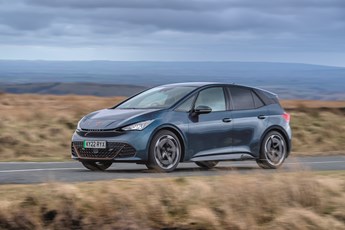
The start point for the best source of fleet information |
First drive: Cupra Born
Date: 06 June 2022 | Author: Martyn Collins

|
|
||||||||||||||||
The Born has taken a while to get to production. We can remember pawing over the prototype el-Born at the Geneva Motor Show back in 2019. More than two years on and we're staring at a production car that looks largely the same, although it now has a badge from Seat's upmarket performance arm Cupra, and the el-Born name has been shortened to Born.
On top of the badge and name change, during its extra development time, the Born's exterior design has been toughened up. The similarity in the basic shape with the Volkswagen ID3 is still obvious. But outside, it has its own LED headlights, there's a more aggressive front air dam with copper highlights that are a feature of the exterior and interior, plus a smaller, concaved grille with CUPRA spelt out.
Moving to the side, the wheels are up to 20ins in size on the range-topping V3 that we drove and there are also chunkier side skirts with their neat little fins. At the back of this Cupra EV, there are those unique LED lights, a bigger rear spoiler and a distinctive lower diffuser.
Like the basic shape, the interior architecture is remarkably similar to the Volkswagen. But the plastics, copper highlights and trim have a far more premium feel, in the same way we were impressed with the interior of the Formentor crossover.
On top of this Cupra's premium feel, the single piece sports seats and the leather-trimmed three-spoke steering wheel increases the sportiness. Best summed up as supportive, these seats even come with a welcome massaging function on the range-topping V3 version. As an aside, these seats are also trimmed in a fabric called Dinamica, which looks like suede, but is made from old t-shirts and plastic bottle tops.
The Born might feel sportier and more sophisticated than the ID3, but there's the same roomy feel, thanks to the tall body and large windows. Rear space remains excellent, and the boot has a practical 385 litres of space that's expandable by folding the rear seats.
There are two battery variants and three equipment grades to choose from (V1, V2 and V3). The Born is offered with the choice of a 201hp 58kWh model with 264 miles range on the WLTP cycle, or a 228hp e-Boost 58kWh model with 261 miles of range. The fastest-accelerating model (228hp e-Boost 58kWh) hits 31mph from standstill in just 2.6 seconds and goes on to 62mph (100km/h) in 6.6 seconds. Although, the 58kWh version that we drove didn't feel slow with 0-62mph acceleration in 7.3 seconds.
The Born is compatible with both AC and DC charging networks, and customers can add 62 miles (100km) of range in as little as seven minutes, using a 135kW charging point on 77kWh battery versions. The battery can be recharged from 5% to 80% in as little as 36 minutes (135kW).
On the road, the Born has lowered suspension, specially developed wider tyres, a more direct variable ratio steering, and a reworked stability control system, compared with the Volkswagen sister car. Together, these changes result in an EV that has more grip, with tighter handling, body control and precise steering. Far more engaging than the ID3, it's surprisingly comfortable and composed, yet good fun when the tarmac gets twistier.
It is not all good news, as the brakes could do with more feel and modulation. Plus, although improved, the Volkswagen infotainment system is harder work than it should be to operate. Despite this, the Born must be one of the most fun-to-drive EVs around, with a sophisticated, sporty feel that the ID3 doesn't get near to, and all with prices starting at under £40,000.
Cupra Born 58kWh V3
P11D: £38,335
Residual value: 47.6%
Depreciation: £20,088
Fuel: £3,569
Service, maintenance and repair: £2,249
Cost per mile: 43.17p
Range: 261 miles
CO2 (BIK %): 0g/km (2%)
BIK 20/40% a month: £12/£25
Luggage capacity: 385 litres
Engine size/power: 201hp with 58kWh battery
Verdict |
9/10 |
|||
 |
|
 |
|
|










